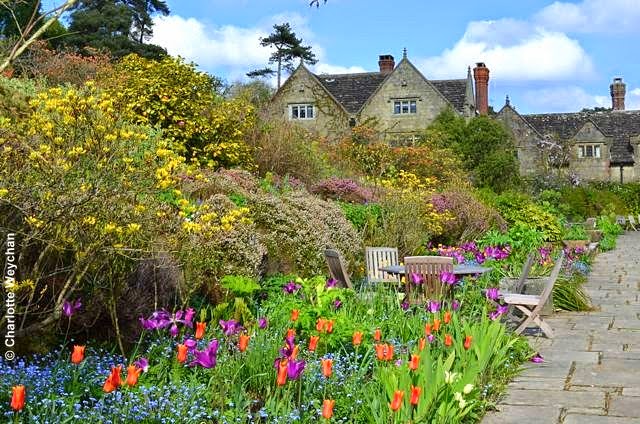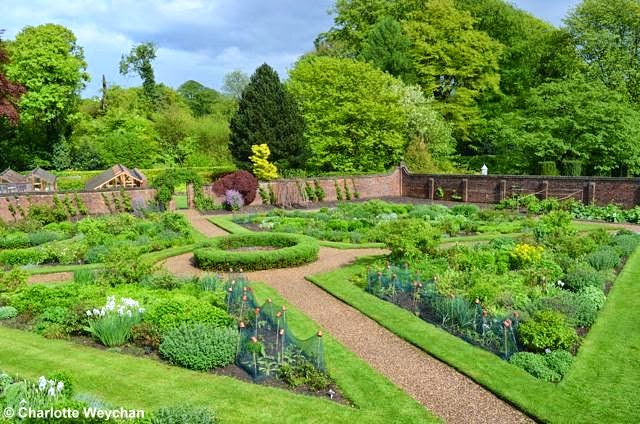![]() |
| Powis Castle sits high on a hill overlooking the Severn Valley in Wales |
Powis Castle enjoys a spectacular hilltop position overlooking the undulating Welsh countryside. In the past it served as a fortress, built for the Welsh Princes of Powys, but today it is something of a phenomenon, akin to the legendary Hanging Gardens of Babylon, with a series of terraces perched on the side of a hill and spectacular views over the Severn Valley. It is certainly one of the most unusual gardens in Britain and draws hundreds of thousands of visitors every year.
![]() |
| The views from the terraces at Powis Castle are truly memorable |
The garden at Powis is a series of terraces filled with extravagant planting, ornate Italianate balustrades and statuary, as well as ancient, oversized, clipped yew trees that add drama to the stage here. The castle dates back to the 12th century, but was added to and extended some 500 years later. The garden there today has its origins in the late 17th century, when William Herbert, 1st Marquess of Powis, employed architect William Winde to create a series of terraces below the castle. But work was never completed, because Herbert was forced to flea to France in 1688.
![]() |
| The Orangery Terrace at Powis Castle |
It was his son, the 2nd Marquess, who commissioned a European gardener, Adrian Duval to complete the garden in the early 18th century and he introduced many of the Dutch influences here, including the Pleasure Garden at the bottom of the valley and a water garden that no longer exists. But by 1770 Capability Brown had exerted so much influence on the way gardens were conceived in Britain, with emphasis primarily on the landscape, that the incumbent Earl of Powis commissioned Brown's Welsh counterpart, William Emes to create the Wilderness area opposite the castle.
![]() |
| The terraces at Powis Castle were carved out of rock and provide a sheltered habitat for many exotics |
More changes were made to the garden under the direction of the Violet, wife of the 4th Earl of Powis in the late 19th century - a keen gardener herself. But, after her death in 1929, nothing changed until the National Trust took over the property in 1952. Since then, it has been turned into a garden to provide year-round interest, although all the original features including ornaments and statuary have been retained. Today the garden is renowned for its striking borders on the 180 metre-long terraces below the castle.
![]() |
| Views from the terraces over the surrounding Welsh countryside are spectacular |
What is surprising about the garden at Powis is the large number of exotics growing here. You will find Chusan palms, bananas and cannas in abundance, and even a rice-paper tree (Tetrapanax papyrifer), yet the climate in this part of the country is not tropical. In fact, it is notoriously prone to low temperatures in winter time and heavy rainfall throughout the year. But it is the reflected heat of the terrace walls that encourages these hardy exotics to thrive (and the ability of a committed gardening team to move them to warmer locations during the colder months).
![]() |
The formal garden and original gardener's cottage at Powis Castle -
today it is available to rent |
Another striking feature of the garden at Powis is the topiary, which remains in the mind long after your visit to the castle gardens is over. There are 14 yew tumps (above) on the terraces and they are enormous. So too is the amount of work required to maintain them. It used to take 10 men four months every year to clip all the hedges and tumps by hand, using hand shears, balanced on extremely tall ladders. But today power shears are used and it only takes two men three months to clip the yew.
In total In total there are almost 8,500 square metres of formal hedging at Powis and that's in addition to the 7,000 square metres of yew tumps. But modern methods, including the use of hydraulic cherry pickers mean that the task of keeping the yew and box in shape is now manageable.
The formal garden is at the lowest point of the 24 acres of gardens surrounding the Castle - best seen from above if you don't want to climb too many steps on your way back to the car park. There are avenues of apples and pears here, surrounding the former Gardener's Cottage, built in traditional Welsh black and white timber style. On a cross axis to the fruit trees is the vine arch (above), which was just beginning to show signs of life when I visited in early Many. Later in the season it is a riot of colour.
Look out for the less obvious features here at Powis, like the crested gates hidden at the rear of the terraces (above) and make sure you stroll through the Wilderness opposite the castle. The views from here are also spectacular and you will be able to appreciate the true scale of the terraces from below. There are many specimen trees here, including Californian redwoods, as well as a huge collection of azaleas and rhododendrons, which give wonderful colour in springtime.
Powis Castle and its gardens are open throughout the year (see website for details as winter and summer opening times vary). Admission prices also vary, according to season, but National Trust members go free. Well worth combining with some of the great Shropshire and Herefordshire gardens if you are in the area, including Wollerton Old Hall and Hergest Croft. 


























































































































































